Friday, April 23, 2010
Choropleth Maps
A choropleth map is a type of thematic map. Areas are shaded or patterned in proportion to the variable being displayed. There are many different types of choropleth maps, all having different ways of portraying the variable. This choropleth map shows the deaths per 1000 live births in Australia. The deaths are represented by the shading, the darker the shading, the higher the death rate is and vice versa.
Hypsometric Maps
A Hypsometric map is a topographic map that portrays the different ranges of elevation with different shades of a color. The relief of an area is shaded in relevance to it's height. For example, in this topographic map of Maryland, you can see that the higher parts of elevation are located in the west of the state, because the darker the shade, the higher the elevation.
Unclassed Choropleth Maps
An Unclassed Choropleth map portrays it's data values by shading. An unclassed choropleth map does not break down the information into intervals. Instead of knowing the exact numeric data, you have to analyze the map on its shading. The darker the shading, the higher the numeric value is, and the lower the numeric value is, the softer the shading will be.
Classed Choropleth Maps
A Classed Choropleth map is a type of choropleth map that portrays information that is classified and broken down into different intervals. This map's information is classified and broken down into 4 intervals of ages.
Parallel Coordinate Graph
A parallel coordinate graph is a graph that plots all the points of data set on one single graph. By doing this, it is easy to understand and compare the distribution of data. From this parallel coordinate graph it is easy to see information about the data set for example, the highest and lowest value points .
Continuously Variable Proportional Circle Map
A Continuously variable proportional circle map utilizes circles to portray the size of the value point. A circle will be proportional to the size of the data for a specific variable. Sometimes, information can be given within the circle, like this map above.
Black & White Aerial Photo
Black and white photos give a unique look to areas and images. Black and white infrared film is sensitive to a specific light spectrum and have a high sensitivity to blue light wavelengths. Black and white photos are usually shot at weddings, for landscape, and for art. This image is a black and white picture of Destin, Fl.
Infrared Aerial Photo
 http://www.krisweb.com/krissheepscot/krisdb/html/krisweb/watershed/sanrafael_nasa.jpg
http://www.krisweb.com/krissheepscot/krisdb/html/krisweb/watershed/sanrafael_nasa.jpgAn Infrared aerial photo is a photo taken by Infrared Aerial Photography. An Infrared aerial photo is a photo taken off of ground level and not standing on anything (usually by plane or satellite). An Infrared film is sensitive to a particular spectrum of light. An Infrared aerial photo can be anything from photos of river deltas, roofs of buildings, the top of a rain forest and etc. An Infrared aerial photo can help educate people with problems by producing images such as the ice melting in the Arctic, the erosion of land, and problems with deforestation.
PLSS Maps
PLSS, the Public Land Survey System, is a method used to identify public land parcels. The Federal Government can utilize the PLSS to survey the land and be able to distinguish where distribute agriculture or anything else on it.This map is Minnesota's PLSS Base map.
Isoline Maps
Bilateral Graph
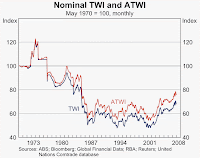 http://www.rba.gov.au/publications/bulletin/2008/feb/images/aug-twi-aus-dol-graph4.gif
http://www.rba.gov.au/publications/bulletin/2008/feb/images/aug-twi-aus-dol-graph4.gifA Bilateral Graph is a graph that represents more than one variable. A Bilateral Graph can be portrayed by many different types of graphs, from line graphs to bar graphs. In this Bilateral Graph, the two variables that are being compared are the Nominal TWI and ATWI are represented by a red and blue line.
Range Graded Proportional Circle Map
A Range Graded Proportional Circle map is a type of Proportional Circle map. A Range Graded Proportional map represents the range of the data by the size of the circle. For example, in this map of Mexican population, you can see that the states of California and Texas have the largest population of Mexicans in the west by the size of the circles compared to the other states'!
Bivariate Choropleth Maps
A Bivariate Choropleth map portrays two variables on a single map. For example, this map represents the population of 1997 (with the color) and it also represents the median house value (by the dots).
Univariate choropleth maps
A Univariate Choropleth map portrays a map representing one specific variable. This map is an example of a Univariate Choropleth map because it represents one specific variable, the percentage of people in poverty in America.
Unstandardized Choropleth Maps
An Unstandardized Choropleth map utilizes data that has not been averaged and is just random data points. An Unstandardized Choropleth map is not very useful because the numbers are not based on averages and are portrayed as an unorganized data group. In this map, the numbers are not averaged, the values are at random.
Standardized choropleth maps
A map has to be standardized in order to have information to compare it too. A Standardized Choropleth map standardizes information, such as population per square mile, in order to have comparisons of the distributed data. This map is standardized because it calculates the population per square miles in order to be able to compare the distribution of the data.
Nominal Choropleth Maps
A Nominal Choropleth Map is a choropleth map portraying information by using nominal data. For example, this Nominal Choropleth map shows each the percent of minority groups each state has. From this map, you can see that most states have a high amount of Hispanic minority groups.
LIDAR
LIDAR, also known as Light Detection And Ranging, is a remote sensing system used to collect information of topographic features. A LIDAR measures scattered light to find information of a specific feature. Many fields of study utilize LIDAR, such as geography, geology, geomorphology and etc.
Correlation Matrix
A Correlation Matrix shows the correlation between two variables. A Correlation Matrix is represented by square symmetrical (MxM). A Correlation Matrix of often used in statistics.
Similarity Matrix
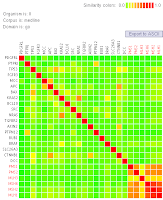 http://tomcat.esat.kuleuven.be/txtgate/images/distmat.png
http://tomcat.esat.kuleuven.be/txtgate/images/distmat.pngA Similarity Matrix is a matrix of values that show the similarity between 2 value points. When there is a higher score, there are more similar characters and when there is a lower score, there are more different characteristics. With a higher score (more similar characteristics) there is a higher value between the two data points, and vice versa.
Population Profile
A Population Profile is a chart that shows the number of people in a specific area (country) in relevance with their age. A population profile can inform people about the demographics of a country. By looking at a population profile, you can see the difference is women and men with age, whether or not their is a high infant mortality rate, or if their is a high senior citizen rate. This Population Profile shows that there is a high birth rate while around the age of 30, the population seems to decrease rather rapidly. This profile also shows that there is a slightly higher birth rate of male babies.
Triangular plot
A Triangular Plot is used in geology to show the composition of soil and rock. The Triangular Plot has 3 main variables: silt, sand, and clay. A Triangular Plot can help educate farmers and other people what is really in the soil and rock of an area, and if it would be smart to farm/plant there. In this Triangular Plot, you can see that the soil and rock is made of up mostly clay and sand particles.
Windrose
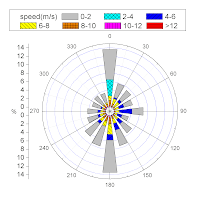 http://lion.cs.uiuc.edu/projects/wsn_ornl/windrose.png
http://lion.cs.uiuc.edu/projects/wsn_ornl/windrose.pngA Windrose is a tool used by meteorologists. A Windrose calculates and portrays the wind speed and direction that is distributed in a specific area. Similar to a compass, a Windrose portrays the wind direction by using the 360 degree scale and the speed by miles per second.
Lorenz Curve
A Lorenz Curve is a graph portraying the proportion of a specific distribution by utilizing the bottom percent of the values. If the Lorenz Curve is straight, this implies that all of the values are equal, it is called the "line of equality". When the values are not all equal, the curve line falls under the line of equality. The Lorenz Curve is often used in economics and ecology. In this graph, the green line represents the line of equality, the red line represents the Lorenz curve, and the blue line represents the line of perfect inequality.
Doppler Radar
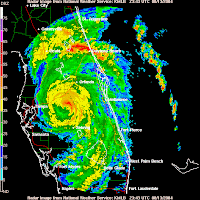 http://www.weatherusa.net/blog/images/doppler-orlando-1943.gif
http://www.weatherusa.net/blog/images/doppler-orlando-1943.gifThe Doppler Radar is a radar device that utilizes the Doppler effect (the change of frequency of a wave). The Doppler Radar tracks a clouds motion, by tracking its microwave radiation and then measuring the attenuation in the return pulse. By tracking the microwave radiation, you observe and calculate the cloud's reflectivity and velocity. Doppler Radar if often utilized for tracking tornadoes.
Thursday, April 22, 2010
DRG (Digital Raster Graphic)
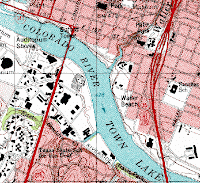
http://www.tceq.state.tx.us/assets/public/gis/images/drg.gif
A Digital Raster Graph portrays a topography image from the U.S. Geological Survey that has been scanned into a computer. After being scanned, a DRG still shows borders, streets, and the non flat features look as if they were flat. For example, in the DRG above, you can see the buildings in the black, the streets, and the borders of the area and the river.
DLG (Digital Line Graphs)
A DLG, often used by the U.S. Geological Survey, is a digital vector representation of information. A DLG can show information such as boundaries, borders, roads, and other data represented by lines, curves, and other shapes. This DLG shows different boundaries, borders, and the hydrography of a specific area.
DOQQ
A DOQQ, also known as Digital Orthophoto Quadrangle, is a computer made image of a specific aerial photograph. The DOQQ takes the aerial image, and removes different factors affecting its clearness, such as features of topography and terrain or camera tilts. Like the DEM, the DOQQ us often utilized by the U.S. Geological Survey.
Digital Elevation Model (DEM)
A DEM is represented by a raster, what we learned to be a grid of squares. A DEM is a digital representation of the topography and terrain of a ground surface. The most common DEM is utilized with the U.S. Geological Survey.
Saturday, April 17, 2010
Cartogram
A Cartogram is similar to a Thematic map. A Cartogram map represents a specific variable by transforming the size of an area with the size of the variable. For example, this map is showing the popular votes of the 2004 presidential elections, in which the counties have been rescaled to represent it's population.
Flow Maps
A Flow Map shows the movement of people or objects from one location to another. A Flow Map can be used to portray migration patterns of people or animals or it can show the migration of objects, such as trucks or cars. A Flow Map can also be used for organizing and ordering data. Most Flow Maps are drawn by hand. This Flow Map represents the total combined truck flows in Texas in 1998.
Star Plot
A Star Plot is used to portray data. Each star represents a specific value. A Star Plot is used to portray a large group of data and is created with a specific design in order to portray that information. Each distance of the stars and radius represents a specific value.
Proportional Circle Maps
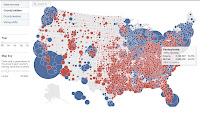 http://propagandica.files.wordpress.com/2008/11/circlesizeisproportionaltotheamounteachcountysleadingcandidateisahead.jpg
http://propagandica.files.wordpress.com/2008/11/circlesizeisproportionaltotheamounteachcountysleadingcandidateisahead.jpgA Proportional Circle Map portrays data with the use of circles. The circles, which can be in different sizes, show information about a specific data group. This map represents the amount of propaganda Obama and McCain had on specific areas. From this map, you can tell that Obama focused in states in the north, south, and west, while McCain focused his propaganda in states in the middle of the country.
Isotach Map
An Isotach map is a type of a contour map. An Isotach map is used to show equal points of wind sped in an area, using isotach lines, which are a form of contour lines.
Isohyetal Map
An Isohyetal map is another type of Contour map. An Isohyetal map uses isohyets, a form of contour lines to represent equal points of precipitation of an area.
Histogram
A Histogram is used in statistics to show different frequencies of data represented by rectangular boxes. For example, in this Histogram, representing employee salary, the X axis shows different salary groups and the Y axis shows the frequency. From this graph you can see that about 46 employees make a salary around 2100-4290 and about 10 employees make about 4290-6480 a year.
Box Plot
 http://edubuzz.org/blogs/nbhs3x1/files/2007/01/boxplot-2.JPG
http://edubuzz.org/blogs/nbhs3x1/files/2007/01/boxplot-2.JPGA Box Plot is used to show the median, upper and lower quartiles, and the minimum and maximum data values of a specific data set. The box holds 50% of the data, the line within the box represents the median, and the end of the lines represent the minimum and maximum value points. This Box Plot represents the annual snow depth at a Nashville Ski Resort. From this graph, you know that the median annual snow depth is around 78, etc.
Stem and Leaf Plot
A Stem and Leaf Plot is used to show the distribution of a data set, while giving specific information about each individual data point. A Stem and Leaf Plot graph is used to organize a large group of data. From a Stem and Leaf Plot you can receive information about the mean, median, mode, and other factors. This Stem and Leaf Plot represents the infant mortality rates in Western Africa.
Index Value Plot
An Index Value Plot represents information either being above average, average, or below a average rate. An Index Value Plot is a type of a visualization map. This Index Value Map represents Tennessee's stream flow during the years 2000-2009. It shows whether or not the stream flow was wet (above average), normal, or dry (below average).
Climograph
A Climograph is a graph used to portray the average monthly temperature and precipitation of a specific place. In this graph, the bars represent the precipitation while the line graph represents the temperature. This Climograph portrays the precipitation and temperature of Memphis, Tennessee.
Dot Distribution Maps
A Dot Distribution Map is often utilized to show pouplation density of a specific area. A dot distribution map can show the actual population of an area or it can portray a specific factor correlating with the population. For example, this map portrays the number of soldiers who live in different areas around the state of Ohio.
Cadastral Map
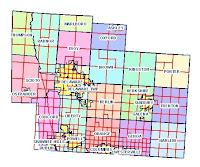 http://www.dalisproject.org/images/cadastral_map.jpg
http://www.dalisproject.org/images/cadastral_map.jpgA Cadastral map is a map that gives information about real property. An example of a Cadastral map is a map that shows the city of Jacksonville, within the city it portrays the different parts of Jacksonville such as Orange Park or Arlington. The point of a Cadastral map is to give as much information for a particular piece of land as possible, for example tax records of the residents, zoning of the land, etc.
Wednesday, March 3, 2010
Statistical Maps
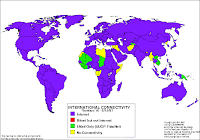 (http://personalpages.manchester.ac.uk/staff/m.dodge/cybergeography/atlas/landweber_version_16.gif)
(http://personalpages.manchester.ac.uk/staff/m.dodge/cybergeography/atlas/landweber_version_16.gif)A Statistical map portrays certain statistical information about individual countries. The statistics can be anywhere from the amount if internet (like the map above), infant mortality rate, population, precipitation, age, etc.
Propaganda maps
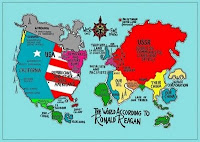
(http://strangemaps.files.wordpress.com/2006/11/800px-reagan-digitised-poster.JPG?w=474&h=362)
A propaganda map is a type of map that is utilized to manipulate people into think specific, and usually untrue things about a certain place. A propaganda map is often used by the government to lead people away from actually knowing definite facts, to believing false, stereotyped characteristics of a country. For example, this is a map that shows how Ronald Regan "views the world", when in reality this is just what he might have stereotyped the places to be. It shows the socialists, communists, and our oil as taking place of the actual USSR, Europe, and parts of Africa.
Planimetric Map
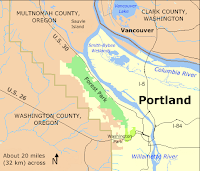 (http://www.squidoo.com/mapcompass)
(http://www.squidoo.com/mapcompass)A Planimetric map is a map that portrays horizontal features. A Planimetric map can be easily mistaken from a Topographic map; however, the main difference is that the Topographic map shows elevation, while the Planimetric shows horizontal features. Some of the features that a Planimetric map portrays are natural and geographical features and features such as rivers, parks, and roads, like in the picture above.
Topographic map
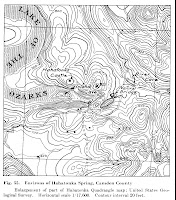 (http://www.rollanet.org/~conorw/cwome/hahatonka_topo_map.jpg)
(http://www.rollanet.org/~conorw/cwome/hahatonka_topo_map.jpg)A Topographic map is a map that utilizes contour lines to represent a phenomena. A contour line is a line that is drawn and connected at equal points of elevation. In a Topographic map, the contour lines usually portray the elevation of hills, valleys, etc.
Friday, January 22, 2010
Thematic Maps
 (http://www.sou.edu/Geography/JONES/GEOG280/stpop96.GIF)
(http://www.sou.edu/Geography/JONES/GEOG280/stpop96.GIF)A thematic map is a type of map that portrays a specific feature or theme of an area. For example, a thematic map can portray the geological area of Africa, while in colors or some other form portray the AIDS ratio among the countries.
Friday, January 15, 2010
Mental Map
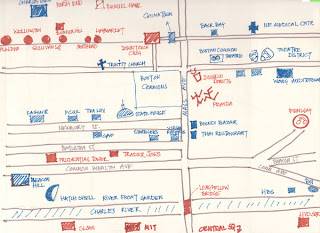 (http://ocw.mit.edu/ans7870/MAS/MAS.965/f04/assignments/tripti/Assignment10/MyMap.jpg)
(http://ocw.mit.edu/ans7870/MAS/MAS.965/f04/assignments/tripti/Assignment10/MyMap.jpg)This specific map is an example of a "Mental Map". Everybody creates their own Mental Maps in their minds using their memory and imaginations. A Mental Map can be considered how peoeple view their own world in which they live. People also create their Mental Maps when remembering how to get places, remembering what different places look like, and to remember what they were surrounded by when at a designated area. Making Mental Maps using your imagination is natural and most people do it without even realizing it!
Subscribe to:
Comments (Atom)








 http://www.lib.utexas.edu/maps/atlas_mexico/mean_annual_precipitaion.jpg
http://www.lib.utexas.edu/maps/atlas_mexico/mean_annual_precipitaion.jpg











 http://www.whitestar.com/images/products/doqq_tx_310.jpg
http://www.whitestar.com/images/products/doqq_tx_310.jpg











